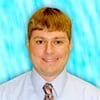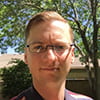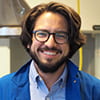Featured Researcher Archive
Featured Researcher Archive

Dr. John Bennewitz is a UCLA postdoctoral research scholar, currently working at the Air Force Research Laboratory within the Aerospace Systems Directorate’s Space & Missile Propulsion Division (RQRC). Dr. Bennewitz’s research focus is on fuel droplet combustion for a range of alternative fuels and additives, as well as characterizing the combustion response of gas centered, swirl coaxial (GCSC) injectors exposed to acoustic excitation with experimental application to liquid rocket engine combustion instabilities. He received his B.S. in Mechanical Engineering from The University of Pittsburgh in 2008, where he then completed his M.S. in Aerospace Engineering from The Georgia Institute of Technology in 2011 and Ph.D. in Mechanical Engineering from the University of Alabama in Huntsville in 2015. Recent projects have included studying acoustically-coupled fuel droplet combustion in UCLA’s Energy and Propulsion Research Laboratory, specifically characterizing sustained oscillatory flame-acoustic coupling, periodic partial extinction and full extinction through phase-locked OH*/CH* chemiluminescence imaging, temporally resolved pressure measurements, and image processing.

Dr. Mitchell Spearrin is an Assistant Professor of Mechanical and Aerospace Engineering at UCLA. Prof. Spearrin’s research focuses on spectroscopy and optical sensors, including laser absorption and fluorescence, with experimental application to advanced propulsion, energy systems, and other dynamic flow fields. Recent projects have included spatially and temporally resolved measurements in supersonic combustion (i.e. scramjet) flows and detonation-based engines, where new performance metrics were developed to understand and advance these systems. Future propulsion research is aimed toward experimental investigation of systems that operate at supercritical conditions, as is the case for most rockets, and the underlying spectroscopy and kinetics associated with those reacting flows. Dr. Spearrin completed his Ph.D. at Stanford University, working in the High Temperature Gas Dynamics Laboratory. Prior to his academic career, Dr. Spearrin worked for Pratt & Whitney Rocketdyne in Los Angeles as a combustion devices development engineer. Prof. Spearrin is currently looking for highly motivated students to join his new laboratory at UCLA.

Alex Schumaker is a Research Aerospace Engineer within the Air Force Research Laboratory Aerospace Systems Directorate’s Space & Missile Propulsion Division (AFRL/RQRC). His current research focus is on the use of hot-fire and cold-flow experimental methods to obtain data on fluid flows, sprays and combustion fields related to liquid rocket engines with the aim to improve design methodologies and increase our understanding of the fundamental physics that control performance, stability and thermal environments in liquid rockets engines. Dr. Schumaker received a B.S. in Aerospace Engineering from The Ohio State University in 2004 and performed his graduate work in Aerospace Engineering at the University of Michigan (M.S. 2006 and Ph.D. 2009). His dissertation research focused on the scaling of reacting and nonreacting coaxial jets at elevated pressures. Using PLIF measurement techniques to measure mixing lengths, Dr. Schumaker was able to extend a method to relate nonreacting mixing length to flame lengths originally developed for simple jets and shear layers to coaxial jets. He was also able to reformulate this method to account for dissociation effects that occur with oxygen-enriched combustion. Since joining AFRL Dr. Schumaker’s primary focus has been on the design and scaling of gas-centered swirl-coaxial injectors and diagnostic methods to characterize dense sprays and high pressure flames. Work on gas-centered swirl-coaxial injectors led to a design method that was used to develop a candidate injector for the Hydrocarbon Boost Demonstration Program. In 2011 Dr. Schumaker led a successful Venture Fund effort that built a high pressure mobile flow laboratory that was used to obtain the first ever X-ray radiography measurements of high-shear sprays. The capability of this system has since been expanded to allow X-ray fluorescence measurements of flames. Dr. Schumaker is currently the AFRL technical lead for the Combustion Stability Tool Development program.

Carleton Knisely is a second-year PhD student in Mechanical Engineering at UCLA and an NDSEG Fellow. Along with Dr. Xiaolin Zhong’s research group, he is involved in a collaborative effort in using advanced numerical tools to investigate fundamental physics of hypersonic flows. One of the group’s primary interests is the effect of surface roughness on hypersonic boundary layer transition. Previous studies by the group have indicated that roughness elements placed in strategic locations on the body can stabilize the boundary layer and delay transition to turbulence. This allows for passive control of boundary layer transition and thereby reduces drag and aerodynamic heating, which can increase the fuel efficiency of a hypersonic vehicle. Carleton’s research will help improve the group’s real-gas thermochemical model and DNS code for the study of real-gas hypersonic boundary layers. His research will help describe the fundamental mechanisms leading to transition (with and without surface roughness) on an ablative surface.

Alireza Mohammad Karim is completing his PhD in Aerospace Engineering at UCLA, under the supervision of Prof. Pirouz Kavehpour. Alireza has performed experimental/theoretical research on the contact line dynamics on ultrahydrophobic surfaces using hydrodynamics theory and molecular-kinetic theory; this research has been recently published in the Journal of Coatings Technology and Research. Alireza has also studied the effect of presence of micro-post patterns on hydrophobic surfaces on the contact line dynamics. Alireza will be pursuing postdoctoral research with Prof. Lorraine Francis (University of Minnesota, Department of Chemical Engineering and Materials Science) on exploring the fundamental connections between coating liquid rheology, curtain stability and air entrainment.

David Rivera is completing his PhD in Materials Science and Engineering at UCLA. He has been a member of the materials in extreme environments laboratory since 2011 and is supervised by Professor Nasr Ghoniem. He was part of a high heat flux materials testing facility development effort. The primary aim of the project was to create a facility capable of simulating the high heat loads seen by materials comprising space re-entry vehicles and fusion reactor systems. Currently, he is involved in an experimental effort aimed at elucidating the plastic deformation modes in tungsten as a direct result of large thermally induced stresses. In addition to the experimental campaign, he is engaged in a modeling effort focused on accurately predicting the plastic distortions seen in the experimental arm of the project. His research interests include: Physics of materials defects, the effects of stress on the damage evolution behaviour of refractory metals, and material degradation in space propulsion systems.

Matthew Harvazinski obtained his Ph.D. in Mechanical Engineering from Purdue University in 2012. He is currently a Research Aerospace Engineer at the Air Force Research Laboratory, Edwards AFB, CA; he has been there since 2012. His current research involves the development and application of computational fluid dynamics (CFD) tools to study liquid rocket engines. Matt is currently involved with the development of a next generation CFD platform designed to study combustion in Air Force relevant problems. He is focused on the development and implementation of models for combustion and turbulence. On the application side his focus is primarily to exercise CFD based tools to predict and study combustion instability, a problem which as impacted rocket engine development since the 1950’s. A recent study described the complex coupling between the hydrodynamics, acoustics, and heat release in a single element combustor that resulted in unstable combustion (published in Physics of Fluids). Matt is also involved with other modeling aspects relevant to Air Force propulsion including conjugate heat transfer, supercritical fluids and real gas equations of state, and the use of detailed combustion kinetics.

Samuel ‘Jun’ Araki completed his PhD at UCLA in the Aerospace Engineering in December 2014, under the supervision of Prof. Richard Wirz. Jun developed a multi-species iterative Monte Carlo model to investigate near-surface magnetic cusp confinement of micro-scale plasma discharges, for micro-thrusters and terrestrial plasma applications. Jun also developed a detailed heavy species collision model using the classical scattering theory with the spin-orbit free potential (published in IEEE Transactions on Plasma Science), which can be incorporated into models for electrostatic plasma thruster plume simulations. His doctoral work also included a numerical studies of a magnetic field aligned (MFA) mesh for plasmas in complex multi-cusp configurations and a particle weighting algorithm for an unstructured mesh like the MFA mesh (published in Journal of Computational Physics). Jun is currently working as a computational plasma scientist at AFRL/RQR, and is currently focusing on GPU implementation of the direct simulation Monte Carlo (DSMC) collision method.

Hai Le just completed his PhD at UCLA in the Mechanical Engineering in December, 2014, working with Dr. Jean-Luc Cambier of AFRL/RQR and Prof. Ann Karagozian of UCLA. Hai performed numerical simulations of a range of reactive and ionizing gas flows, including use of the EPRL’s GPU cluster in benchmarking the benefits of GPU computing for complex reactive flows (published in Computer Physics Communications). Hai also explored model reduction for collisional-radiative (CR) kinetics, with applications to partially ionized plasmas; this work was recently published in the Physics of Plasmas. More recently he extended the CR model to the solution of multi-fluid equations, developing hydrodynamic models for laser plasma interactions. Hai is currently pursuing postdoctoral research with Prof. Russ Caflish (UCLA Math Dept, IPAM) on kinetic similarities of nonequilibrium plasmas.

Dr. Daniel I. Pineda is a UCLA postdoctoral scholar currently working in the Laser Spectroscopy and Gas Dynamics Laboratory in the Department of Mechanical and Aerospace Engineering. His research involves using novel laser absorption spectroscopic methods to interrogate the ignition kinetics of transportation fuel blends for advanced chemical propulsion in aerospace applications. His other responsibilities at UCLA include formally mentoring The Rocket Project at UCLA, an undergraduate student club dedicated to the design, construction, and launching of rockets in intercollegiate competitions. Dr. Pineda received his B.S. in Mechanical Engineering from The University of Texas at Austin in 2012. From there, he continued on to the University of California, Berkeley to complete his M.S. and Ph.D. degrees in Mechanical Engineering with a focus in Combustion in 2014 and 2017, respectively. Recent projects have included uncertainty analysis in flame models and the development and testing of plasma-assisted ignition technologies for use in automotive engines.
